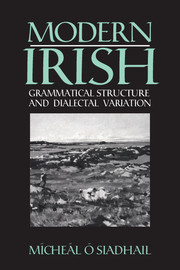Book contents
- Frontmatter
- Contents
- Dedication
- List of tables
- List of figures
- Preface
- List of abbreviations
- 0 General introduction
- Part I Phonology
- Part II Morphology
- Part III Syntax
- 9 Introduction to Syntax
- 10 The copula
- 11 Complementation and modal and auxiliary verbs
- 12 Non-complemental subordination and marginal syntactic features
- Glossary
- References
- Index of Irish words
- Frontmatter
- Contents
- Dedication
- List of tables
- List of figures
- Preface
- List of abbreviations
- 0 General introduction
- Part I Phonology
- Part II Morphology
- Part III Syntax
- 9 Introduction to Syntax
- 10 The copula
- 11 Complementation and modal and auxiliary verbs
- 12 Non-complemental subordination and marginal syntactic features
- Glossary
- References
- Index of Irish words
Summary
Two verbs ‘to be’
There are in Irish two verbs ‘to be’: the copula is and the substantive verb tá; a distinction which bears some resemblance to, for example, Spanish (see Ó Máille 1912). Although this chapter is devoted to the copula, it will be necessary to describe some usages of the substantive verb, particularly where its intrusion on the copula system (see Ó Siadhail 1983) leads to variation among the dialects.
Forms of the copula
This account of the copula begins with a brief overview of the commonest forms and variants of the copula. Basically, it has two sets of forms: one which serves as a present or future and another which serves as a past or conditional. The past/conditional set is the more marked set in that it may not generally be deleted (see 10.4). The bracketed forms in Table 10.1 are used before vowels (or l or r following fh). In order not to complicate the table unnecessarily, the more marginal forms combining with cé ‘who’ and do ‘to’ and ó ‘from’ are omitted. An optional dob(a) (the past marker do + ba) rather than ba for certain Munster dialects has also not been included.
Although the forms in Table 10.1 for the most part occur in descriptions of Galway and Kerry dialects, this tabulation is somewhat idealized and neither reflects the multiplicity of forms which are recorded or offers a picture of the most frequently used forms in any given dialect.
- Type
- Chapter
- Information
- Modern IrishGrammatical Structure and Dialectal Variation, pp. 219 - 252Publisher: Cambridge University PressPrint publication year: 1989



